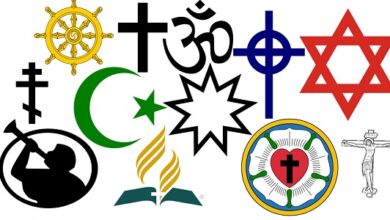What is Enthalpy types Difference between entropy and enthalpy
Enthalpy
It is the thermal energy involved in different types of chemical reactions, in which simple substances have, by convention, enthalpy equal to zero. The enthalpy change can be calculated by subtracting the enthalpy value of the products from the enthalpy value of the reactants , i.e.:
∆ H = Hp – Hr
∆H → Enthalpy change
Hp → Enthalpy of products
Hr → Enthalpy of reactants
The result of the enthalpy change calculation will determine whether we are dealing with a reaction that releases or absorbs heat, as can be seen in the following graphs:
Types
enthalpy of formation
It is the change in thermal energy involved in the formation of one mole of any substance , whether formed based on simple substances or in the ground state, as in the following example:
1/2H 2 + O 2 = H 2 O
→ Note that the reagents are both simple substances, that is, they have an enthalpy equal to 0, and that the enthalpy value of water (H 2 O ) is predetermined in the laboratory, therefore being a given given, therefore, the calculation of the enthalpy change is as follows:
∆H = Hp – Hr
∆H = (-68.4) – (1/2.0 + 0)
∆H = -68.4 → Exothermic reaction
→ Note that we have a result less than 0, which means that, in this reaction of formation of one mole of H 2 O, we will release energy.
enthalpy of combustion
It is the measured change in heat required for the combustion of 1 mole of any substance. Every combustion reaction will have an enthalpy change value less than zero, as it is a reaction that releases heat.
- Example
Reaction and enthalpy change value for the ethanol combustion reaction:
C 2 H 6 O(l) + 3.O 2 (g) → 2 CO 2 (g) + 3 H 2 O(l) ΔH = -326 Kcal/mol
The following are enthalpy of combustion values for some common substances:
- Gaseous ethanol (C 2 H 6 )= -372.8 Kcal/mol
- Liquid benzene (C 6 H 6 ) = -781.0 Kcal/mol
- Solid sucrose (C 12 H 22 O 11 ) = -1348.9 Kcal/mol
binding enthalpy
It is the energy required to break one mole of a chemical bond . The energy variation in this case always results in a value greater than 0, that is, the breaking of bonds requires heat absorption.
- Example
CH 4 (g)+C(g)+4H(g) ΔH = +1,651.6 kJ/mol
C – H → C(g) + H(g) ΔH = +412.9 KJ/mol
Cl – Cl → Cl(g) + Cl (g) ΔH = +242.0 KJ/mol
Of neutralization
It is the energy change in neutralization reactions , such as acid-base neutralization:
Acid + base = salt + water → exothermic
As in other cases of enthalpy, for the neutralization values, the calculations for 1 mol must be considered. In this case, the final value of the enthalpy change will be, for the neutralization reaction, 1 mol of H + to 1 mol of OH –
Of dissolution
It is the variation in thermal energy involved in the dissolution of a mole of a given solute in an “x” amount of water or any other solvent, provided that there is complete solubilization and it becomes a homogeneous mixture .
- Example
NaCl(s) + aq → Na+(aq) + Cl-(aq) ∆H = -0.9 Kcalmol
In the reaction, we can chemically see the dissolution of sodium hydroxide , popularly known as caustic soda, in an aqueous medium. Note that the reaction has an enthalpy change of less than zero, which means that heat is released. This reaction is commonly carried out in the manufacture of homemade soap, a process that, when not carried out with due care, can result in accidents with burns of up to 3rd degree.
Difference and Comparison
- It represents the total energy of a system, while entropy measures the degree of disorder or randomness of the system.
- A positive change in enthalpy implies heat absorption, while a negative change means heat release; increasing entropy indicates increased disorder, while decreasing entropy suggests order.
- It and entropy influence the spontaneity of reactions, with more negative enthalpy changes and more positive entropy changes making reactions more spontaneous.
Enthalpy vs Entropy
The difference between enthalpy and entropy is that enthalpy is a measure of the total energy of a system, which is the sum of internal energy and the product of pressure and volume. On the other hand, entropy is the amount of thermal energy in a system that is not available for its conversion into work.
Comparison table
| Comparison parameters | enthalpy | Entropy |
|---|---|---|
| Definition | It is the sum of internal energy and the product of pressure and volume of a thermodynamic system. | Entropy is the amount of thermal energy of a system that is not available for conversion into mechanical or useful work. |
| Measurement | The total enthalpy of a system cannot be measured directly, so we calculate the enthalpy change. | Measuring the entropy of a system refers to the amount of disorder or chaos present in a thermodynamic system. |
| Unit | The SI unit of enthalpy is the same as that of energy, so it can be measured in J. | The SI unit of entropy for unit mass is J⋅K -1 ⋅kg -1 and for entropy per unit amount of substance is J⋅K -1 ⋅mol −1. |
| Symbol | It is denoted by H. | Entropy is denoted by S. |
| History | A scientist named Heike Kamerlingh Onnes coined the term “enthalpy”. | A German physicist named Rudolf Clausius coined the term “entropy”. |
| Favoring Conditions | A thermodynamic system always favors the minimum enthalpy. | A thermodynamic system always prefers maximum entropy. |


